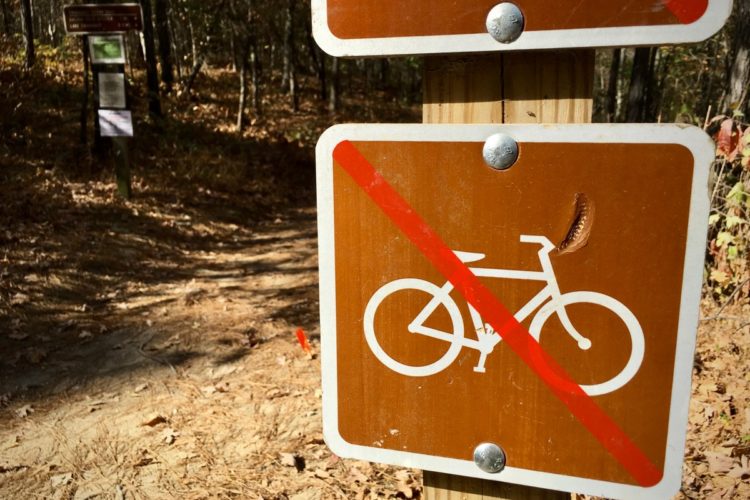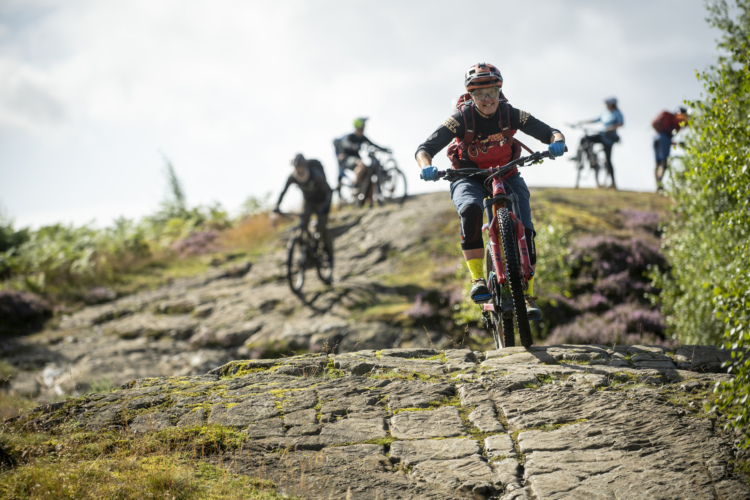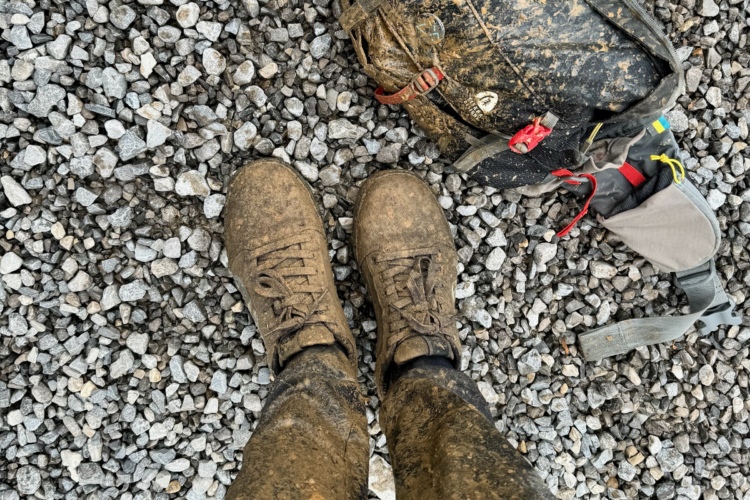
North American mountain biking seems to fall on either end of the continent. The entire Western U.S. is inundated with mountain biking, from New Mexico clear up through the Rocky Mountain states and into Canada.
Mountain biking on the other side of the continent has us thinking of places like Asheville, North Carolina, or, perhaps Le Massif outside of Quebec City, Canada. Other than places like Bentonville, Arkansas, we likely don’t think of much mountain biking happening in the continent’s middle.
Despite the ignorance some of us may have concerning Midwest mountain biking, one look at the Hoosier Mountain Biking Association’s (HMBA) website paints a different picture. Trade those images of rolling fields for heavily wooded forests and chunky trails. HMBA has used the limited 250 or so feet of elevation well.
HMBA’s work provides mountain bikers in and around Indianapolis with much-needed singletrack. However, a new Wilderness bill that has just entered Congress threatens to shut down access to some of those trails. We sat down with Paul Arlinghaus, president of HMBA, to chat about the wilderness bill HMBA and Central Indiana mountain bikers face.
Mountain biking in Indiana
HMBA found its genesis in the late ’90s and early 2000s as Indianapolis lost more and more trail access.
“The predecessor to HMBA was a group in Indianapolis called the ‘Indy Spoke Breakers.’ They started as more of a riding club but transitioned to advocacy as we lost more trail,” Arlinghaus said.
Along with the Indy Spoke Breakers, other groups began advocating for mountain bike trails in and around Indianapolis. With trails mainly in state parks and state forests, the groups worked primarily with the Department of Natural Resources (DNR). In 2004, these groups and clubs came together, forming one advocacy group, HMBA, allowing for a more streamlined process when working with federal agencies.

And Arlinghaus was around from the beginning.
He moved to the Indianapolis area in the mid-90s for the promise of more mountain biking trails. Shortly after he moved, several more popular mountain biking destinations were closed “with enforcement,” as Arlinghaus put it.
Indianapolis area mountain bikers now had one place to ride, and “half of that remaining spot got flattened by a developer,” Arlinghaus reminisced.
So, Arlinghaus began advocating for trails. In 2004, he became the representative for his local trails, landing him a position on HMBA’s board.
In 2005, another board member introduced HMBA to Recreational Trail Program grants, providing $150,000 in grant money with a 20% match from HMBA.
These funds opened the doors for new trails and allowed HMBA to pay their most talented volunteer trail builder, Alex Stewart. In turn, Stewart started his professional trail-building company, Spectrum Trail Design.
“People think that grant built us 10 miles of great trails at Brown County State Park,” Arlinghaus shared. “But we also finished that grant with a professional trail builder in the state.” HMBA continues to work with Spectrum on different projects.
HMBA has built over 100 miles of new trail and maintains over 150 miles of trail since their birth. Among Central Indiana’s mountain biking destinations HMBA is responsible for mountain bike trails in Brown County State Park, Yellowwood State Park, and the area of concern as far as the proposed wilderness bill, Hoosier National Forest.
What is a “Wilderness Area?”
There are many different designations of public land across our country—National Forest, State Forest, State Park, Wildlife Refuge, Conservation Area, National Monument, etc. These lands come with different land managers and varying usage and access degrees.
Some land designations are more restrictive than others.
A “Wilderness area” is one of the most restrictive designations an area of land can receive. The Wilderness Act of 1964 defines it as: “an area where the earth and its community of life are untrammeled by man, where man himself is a visitor who does not remain.”
And, when “man himself is a visitor” to these Wilderness areas, it cannot be on a mountain bike or any other mechanized means of transportation.
Charles C. Deam Wilderness
The bill, entered into Congress by Indiana Senator Mike Braun on September 28, 2023, isn’t a proposed new Wilderness designation but an expansion of a current Wilderness area.
Senate Bill S.2990 seeks to double the size of the current Deam Wilderness area. The bill would add over 15,000 wilderness-designated acreage to Deam’s nearly 13,000. This would be the first expansion of Indiana’s only wilderness area since its designation in 1982.
According to Arlinghaus, it would also mean the end of some great trails in HMBA’s network.
“Normally, there would be a forestry plan, Arlinghaus said. “Out of that plan would come proposals for recreation, habitat, hunters, and perhaps looking for areas to propose as new Wilderness. You create a broad and overall plan for the forest.”
Senator Braun’s proposed Wilderness does not follow that typical path, according to Arlinghaus. “An environmental group has gone directly to the senator, trying to expand this Wilderness. I don’t think the Senator truly understands the negative impacts dedicating the area as ‘Wilderness’ would bring.”
The proposed expansion of the Deam Wilderness encompasses the area’s popular Nebo Ridge Trail and some other trails, fire roads, and gravel roads that cyclists use. But the bill seems to be mountain biker-friendly.
“What they’ve written into the bill is to create corridors that would protect those trails, fire roads, and gravel roads that are inside what they are proposing as wilderness, and then expecting us to support the bill,” Arlinghaus explained.
However, the new wilderness expansion rubbed HMBA the wrong way. It would severely limit any development of new trails in the Hoosier National Forest. It would also limit access to Nebo Ridge, which Arlinghaus described as a hub of sorts, with its location bordering the Brown County trail system.
And while the corridors seem like a legitimate compromise, HMBA doesn’t think they would make it through the final legislation of the bill. Arlinghuas said there are too many groups backing the bill who are opposed to corridors.
“Our concern is a bait and switch. We’re being asked to support the bill because it has corridors in it, knowing at some point the corridors will be pulled out.”
Arlinghaus feels these concerns are legitimate, as they have seen other favorable language removed from the bill. Initially, HMBA took their concerns about the wilderness proposal to Senator Braun himself. “He said, ‘We’ll just write into the bill that you can develop more trails in the area.’ Of course, that didn’t work and was taken out,” Arlinghaus said.
Even with the corridors, the bill would severely limit access to different trails. Currently, HMBA can drive vehicles up forest roads, allowing workers to access different trails easily. If the wilderness bill were to pass and the corridors established, trail maintenance crews, likely volunteers, would have to hike the entirety of trails to do their job.


Pushing for a different designation
The tricky thing many trail organizations, like HMBA, navigate is remaining apolitical in a very politically driven workplace. Staying neutral is difficult when Congressional decisions affect your daily work.
HMBA carefully walks this line, working as best they can with all parties for a reasonable outcome. Their solution? A National Recreation Area (NRA), rather than increasing the Wilderness area.
Wilderness is clearly defined and unchanging. “If you call it a National Recreation Area, in the bill, you can specify what you want,” Arlinghaus said. “If the goal is to limit timber harvest, you just write into the National Recreation bill that you don’t want timber harvest.”
However, that idea was rejected.
The alleged compromise, according to Arlinghaus, was an NRA designation of smaller plots of land around the wilderness area. Arlinghaus says these proposed NRAs don’t work, as they are small and disconnected from one another.
This is where the bill gets its full title: Benjamin Harrison National Recreation Area and Wilderness Establishment Act of 2023. “They’re selling this as a Wilderness inside a rec area,” Arlinghaus said.
The upside
The International Mountain Bicycling Association (IMBA) has been helping HMBA. Though no longer affiliated with IMBA, HMBA has found their assistance invaluable.
“IMBA has a person in Washington [DC] who has been very helpful to us,” said Arlinghaus. “They’ve helped us understand the DC side of how politics work and how this bill would have to go forward.”
Senate Bill S.2990 has a long road ahead. To become law, the U.S. Senate and House of Representatives must approve the bill before President Biden’s signing.
Ultimately, Arlinghaus doesn’t think the bill will pass Congress. He told us that Senator Braun authored the bill without support from the House of Representatives or other senators.
As of our interview, Arlinghaus said the bill has no cosigners. “[Braun] is trying to get those cosigners, but we’ve reached out to those key legislators, and it didn’t seem like they knew anything about this bill.”











9 Comments
Dec 12, 2023
Dec 14, 2023
Dec 13, 2023
Dec 14, 2023
Dec 18, 2023
Jan 10, 2024
Dec 13, 2023
Dec 14, 2023
Jan 10, 2024